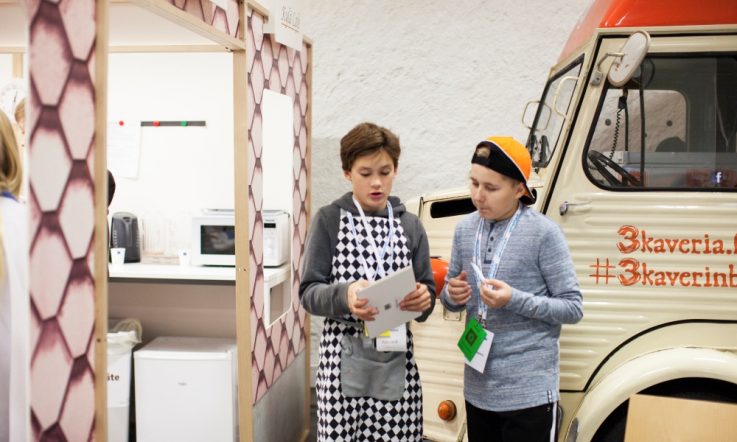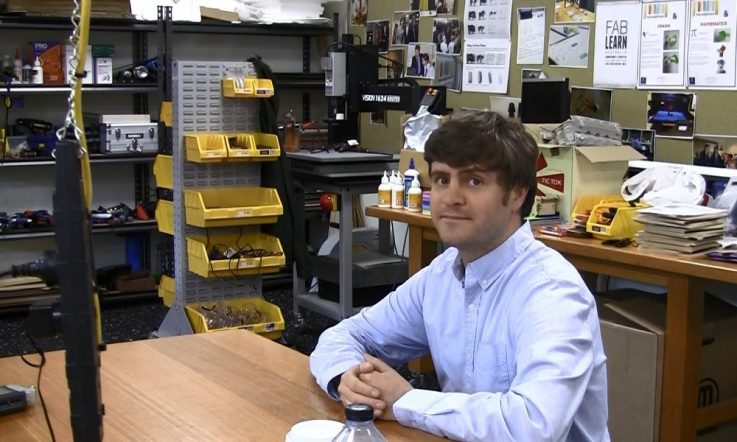Hello, thank you for downloading this podcast from Teacher – I'm Jo Earp. Welcome to Episode 4 in our Global Education podcast series. This month I'm talking with John Burns, Director of Creativity & Innovation at the International Schools Services about his work with the Shekou International School to showcase teaching and learning via social media. The initiative has been such a success that the Chinese school's Twitter hashtag received in the region 20 million exposures last year, and even caught the attention of Banksy.
Jo Earp: John, it's great to have you on the podcast. You spent three years at Shekou International School as Director of Learning Innovation there. First of all, can you give our listeners a bit of background about the school itself?
John Burns: We're an international school in Shenzhen in China, about an hour drive from Hong Kong. Currently we've got about 800 students and we basically serve the expat community - so we have a mix of American, Korean, British, German, French and other students that attend the school. And we're an IB school, so you might be familiar with the International Baccalaureate, which is pretty much the staple program in a lot of international schools around the world.
JE: Now, I mentioned your role there – Director of Learning Innovation. One of the things you were heavily involved in was boosting the social media presence ... for SIS. What did it mean for you? And what did you want to achieve?
JB: Fundamentally, we wanted to de-privatise great teaching and learning. If something great is happening in a Year 2 classroom, it shouldn't be a secret to the classroom next door, it shouldn't be a secret to the middle school, and certainly shouldn't be a secret to the principals and others. So we wanted to find a way that we could get teachers actively discussing and sharing the practice in their rooms, and so we saw a Twitter hashtag as being a really good medium for that. What we have as a result is this organic community of people constantly sharing practice via the hashtag #SISrocks.
JE: So it was just Twitter alone, not Facebook or other channels - what was the decision behind that?
JB: Yeah, I think there's naturally this affinity [for educators] with Twitter and we just saw it as a really easy way to share what was going on through a hashtag.
Facebook is useful for other purposes, it's fantastic for engaging a parent community, it's awesome for closed groups, but we wanted this one to be as open as we could make it. So we saw Twitter as being a good match in that instance.
JE: Now, I'm sure there are some educators and school leaders listening out there who would feel a little bit apprehensive about doing the same thing. So, can you walk us through some of the practicalities involved - things to think about before setting up an account, who runs it in the school and some of the pitfalls?
JB: You do want to mitigate risk, things can go wrong when you've got a large community of people engaging with social media. But we didn't see it as outweighing the potential benefits of what we could have in our school.
I guess the first thing for us was we wanted to identify in the school the types of great practice that we valued. So, at the coalface of teaching and learning, what were the types of pedagogy that we really valued? And our learning coaches in the school went out and actively started capturing that - simple photos, simple videos, little quotes from the teachers engaging – and then started using the hashtag #SISrocks rather than a school Twitter account. So we started down that path and sort of showcased the great types of practice we wanted to see.
From there then, we offered professional learning. So we had teachers (if they wanted to, it was all voluntary) come in and learn how to best engage with Twitter, what are the types of great things we want to see shared by Twitter and what are some of the things maybe you don't want to share, particularly given our context in China. And then we built off that - we talked about retweets, endorsements and favourites – and then slowly attracted more teachers to join that group, to the point now where probably about three quarters of the staff at SIS are engaging with that hashtag, which is phenomenal. I think last year they saw in the order of 20 million exposures to what was occurring in the school through the use of the hashtag.
JE: Wow. So actually, the practically of who runs it is not an issue in this case because you've done it where people dip in and out and it's through the hashtag?
JB: Yeah, precisely, it's completely decentralised and that does pose some risks. What if someone posts something inappropriate? What if someone from outside the school does that? And, largely, in the last three years we haven't seen that, it just really hasn't been an issue. I guess because of the positive way the learning coaches approached it, the leadership approached it, and really documenting and showcasing ‘these are the types of things we want to see in that space'.
So, we see discussions around teaching and learning, we see discussions around passion projects and genius hour-type things. We've seen a change to our recruiting landscape, where teachers who are potentially vetting the school or want to come here are talking to staff and engaging with staff before they arrive. And there are some students involved as well, and we'd like to see more of that.
... whenever a student enrols in our school, we have a media release so the parents are aware that we might use their pictures and images in their school blogs, we might use them in their Year Book (which is an iBook), we might use them in Twitter. Parents can opt in or out of all of those. Across the school I'd say there's probably only three or four students we have off those lists and teachers in those classrooms are highly aware of that. So they know ‘If I'm going to post anything to Twitter, if I'm going to post a video to YouTube then these students can't be included in that'.
JE: What about access to that, it's open access isn't it? Do you find that the parents engage on Twitter?
JB: It's a little trickier in our context with the parent community because we are in China and some access to social media is a little bit more difficult, but we do have some parents engaging. Primarily for SIS though, it was about that community of practice, great teaching and learning at the forefront and a constant discussion around what that actually looks like.
JE: Now, you've mentioned some of the benefits there, including recruitment. What are the some of the other plus points? I understand it's led to more collaboration.
JB: It's been really quite interesting. We've seen vertical collaboration occur in the school now and it was quite organic. So, an art initiative and a science initiative between the Elementary School, the Middle School and the High School where there are kids P/K-12 working together and learning together in probably more of an authentic way than happens sometimes traditionally in the classroom.
You know we've seen marketing benefits to the school - the school's profile has risen dramatically because of this exposure via Twitter. That has helped with recruiting in some regard, and also with our enrolments and boosting the profile of the school.
And we've loved something that's only recently started emerging - the connections with professionals. There's been some fantastic moments where artists like Banksy have 'liked' some of the work that's been posted online from our Elementary School art teachers. And these other collaborations that have happened that normally you wouldn't have exposure to, or students would just never experience in a traditional classroom setting.
JE: That's all from this episode of Global Education. John Burns, thanks for talking to us today and good luck in your new role at the International Schools Services.
JB: No worries, thanks Jo.
For more information about this podcast and to access other articles and videos, visit www.teachermagazine.com.au. Or, join our community on social media via Facebook and Twitter.
- Make sure you don't miss a Teacher podcast, subscribe for free by visiting acer.ac/teacheritunes or www.soundcloud.com/teacher-ACER.
Are you using Twitter as a professional development resource?
Have you created connections with colleagues via the social media site that you would not otherwise have linked with?
Do staff at your school use a common hashtag?
Related Teacher content: Educators and Twitter



